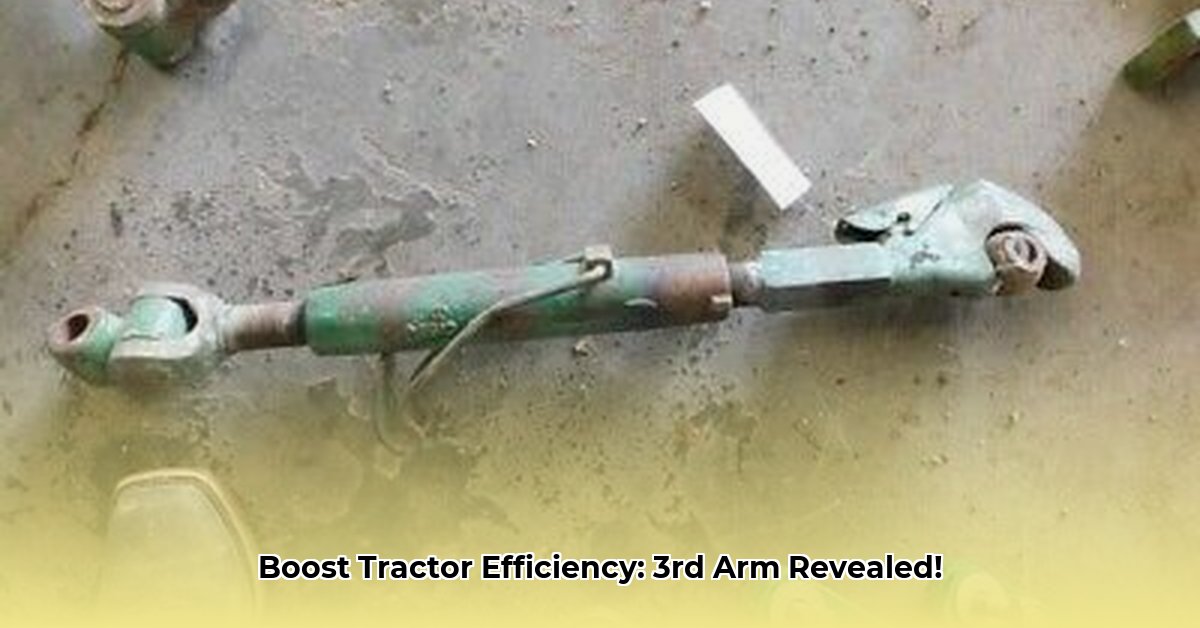
3rd Arm for Tractor: Revolutionizing Farm Work
Imagine wrestling a stubborn tiller into perfect alignment on your tractor – a sweaty, dangerous task. Now imagine a robotic assistant doing it for you. That's the promise of the third arm for tractors, a technology quietly transforming agriculture. This innovative system isn't a literal extra arm, but a sophisticated combination of electric motors, sensors, and intelligent software, acting as an automated lift arm adjuster for your tractor's implements (planters, harrows, tillers, etc.). It's attached to your tractor's hydraulics and uses sensors to constantly monitor implement position. Any misalignment triggers automatic adjustments, streamlining the process and significantly enhancing safety. Isn't it time you considered this game-changer? For more on tractor attachments, check out this helpful resource.
How a Third Arm Works: Precision and Automation
This "third arm" enhances precision farming, reducing waste, and optimizing resource use. It meticulously manages the implements attached to your tractor, ensuring perfect alignment and functioning. This automated system significantly reduces the risk of accidents during implement adjustments as it removes the need operator from operating in the tractor's hazardous "crush zone".
Advantages: Beyond Mere Convenience
The benefits of this automation extend beyond convenience:
Increased Efficiency & Productivity: Early reports suggest substantial time savings; potentially translating to significantly increased yields and profits. How much time could you save by automating the adjustments of your tractor's implements? This alone could drastically improve your bottom line.
Enhanced Safety: The third arm minimizes the risk of injury by eliminating the need for manual adjustments in the tractor's dangerous crush zones. Isn't worker safety paramount?
Cost Savings: Increased efficiency means lower operating costs per unit, positively impacting your profitability. Reduced downtime and fewer accidents translate directly to a healthier bank balance.
Environmental Benefits: While further research is needed, early indications suggest the third arm’s operation might improve energy efficiency, potentially reducing your carbon footprint. Could this technology pave the way for a greener farming future?
Challenges and Limitations: Acknowledging the Realities
While promising, challenges exist:
High Initial Cost: The upfront investment can be significant, representing a considerable hurdle for some farmers.
Compatibility Issues: Integrating the system into existing tractor setups can be complex, especially with older models. Extensive modifications might be necessary, increasing overall cost.
Lack of Long-Term Data: Comprehensive long-term sustainability data regarding environmental impact, operational lifespan, and recycling procedures is still limited.
Risk Assessment Matrix: A Balanced Perspective
Understanding risk is critical. This matrix evaluates potential risks associated with adopting a third arm:
| Feature | Risk Category | Likelihood | Severity | Mitigation |
|---|---|---|---|---|
| Electrical System Failure | Equipment Malfunction | Medium | High | Redundant systems, preventative maintenance, robust design |
| Compatibility Issues | Integration Failure | Medium | Medium | Thorough pre-purchase testing, compatibility checklists, software updates |
| High Initial Cost | Financial Constraint | Low | Medium | Government subsidies, leasing programs, financing options |
| Lack of Long-Term Data | Environmental Impact | High | Low | Ongoing research, life-cycle assessments, responsible manufacturing practices |
The Future is Now (Almost): What Lies Ahead?
The future potential is enormous:
- Reduced Costs: Ongoing technological advancements and scaled production are expected to drive down costs.
- Improved Integration: Seamless integration with precision farming technologies (GPS guidance, sensor-based monitoring) will further enhance efficiency.
- Enhanced Automation: Future iterations might lead to more comprehensive automation, freeing farmers to focus on strategic tasks. Imagine a fully automated farming system!
However, standardized safety and efficiency protocols spearheaded by regulatory agencies are crucial for wide adoption and responsible use.
Call to Action: Shaping the Future of Farming
The third arm represents a significant step towards more sustainable and efficient farming practices. Farmers, manufacturers, researchers, and policymakers all have a crucial role in nurturing its development and ensuring responsible adoption. This technology holds immense promise for improving yields, reducing human risks, and ultimately sustaining a stronger, more productive agricultural sector. Are you prepared to embrace the future of farming?